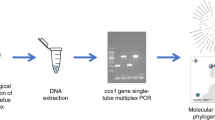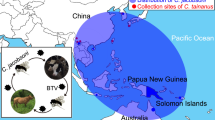Abstract
When studying the vectorship of Culicoides species during the outbreak of Bluetongue disease (BTD) in Central Europe, the question arose whether the most common species and additionally proven vectors of BTV (C. obsoletus and C. pulicaris) are definitive species or do they belong to so-called complexes, since the determination based on morphological criteria is not very significant and knowledge on the life cycles is poor or even absent. Therefore, the present molecular biological study on their ITS-1, ITS-2 and 18SrDNA characteristics was initiated to investigate specimens, which had been determined by their wing morphology during an entomological monitoring in the years 2007 and 2008 at 91 farms in Germany (Mehlhorn et al. 2009). This study revealed novel types respectively different forms, which appeared very similar to Culicoides obsoletus, but showed slightly varying wing patterns. The molecular biological data were compared to those in data banks and combined to provisional dendrograms. The ITS-1 and ITS-2 analysis showed that the specimens determined in the monitoring as C. obsoletus inclusive those with different wing pattern correlate significantly with the data of C. obsoletus in the data banks and surrounded the data bank specifications of C. montanus and C. scoticus so closely that the latter might be only hardly separate species. A similar interpretation can also be drawn when looking at the 18S rDNA dendrogram. Thus, C. scoticus and C. montanus might be races of C. obsoletus rather than separate species. With respect to the ITS-1 and ITS-2 characteristics of C. pulicaris females, which morphologically and by size can be significantly differentiated from C. obsoletus, it was seen that this species is significantly situated on another rame of the dendrograms and in very close relationship to C. punctatus and C. lupicaris, so that the latter might also be only races of C. pulicaris. One of the two other most common species found in Northrhine–Westfalia—C. festivipennis—belongs to the rame of the dendrogram, where C. pulicaris is situated close to C. circumscriptus, while the other common species (C. nubeculosus) has its place close to C. puncticollis and C. variipennis on the rame, where C. obsoletus is found. Thus, this paper again clearly points out that the question “what is a definite species” is far from being solved, if the life cycle is not defined and morphology misleading. However, it also became clear that C. obsoletus and C. pulicaris are Europe-wide occurring species and that several other clearly described separate species are probably only races.



Similar content being viewed by others
References
Breslauer KJ, Frank R, Blocker H, Marky LA (1986) Predicting DNA duplex stability from the base sequence. Proc Nat Acad Sci 83:3746–3750
Cetre-Sossah C, Baldet T, Delecolle JC, Mathieu B, Perrin A, Grillet C, Albina E (2004) Molecular detection of Culicoides spp. and Culicoides imicola, the principal vector of bluetongue (BT) and African horse sickness (AHS) in Africa and Europe. Vet Res 35:325–337
Conraths FJ, Kramer M, Freuling C, Hoffmann B, Staubach C, Gethmann J, Teifke J, Mettenleiter TC, Beer M (2007) Bluetongue disease in Germany: clinical aspects, diagnosis and epidemiology. Der Prakt Tierarzt 88:9–15
Conraths FJ, Gethmann J, Staubach J, Mettenleiter TC, Beer M, Hoffmann B (2009) Epidemiology of BTV in Germany. Emerg Inf Dis (in press)
Elsheikha HA, Lacher DW, Mansfield LS (2005) Phylogenetic relationships of Sarcocystis neurona of horses and opossums to other cyst-forming coccidia deduced from SSU rRNA gene sequences. Parasitol Res 97:345–357
Gumulski LM, Meiswinkel R, Delecolle JC, Goffredo M, Gasperi G (2006) Phylogeny of the subgenus Culicoides and related species in Italy, inferred from internal transcribed spacer 2 ribosomal DNA sequences. Med Vet Entomol 20:229–238
Hwang UW, Kim W (1999) General properties and phylogenetic utilities of nuclear ribosomal DNA and mitochondrial DNA commonly used in molecular systematics. Korean Parasitol 37:215–228
Jeanmougin F, Thompson JD, Gouy M, Higgins DG, Gibson TJ (1998) Multiple sequence alignment with Clustal X. Trends Biochem Sci 23:403–405
Mehlhorn H, Walldorf V, Klimpel S, Jahn B, Jaeger F, Eschweiler J, Hoffmann B, Beer M (2007) First occurrence of C. obsoletus-transmitted Bluetongue virus epidemic in Central Europe. Parasitol Res 101:219–228
Mehlhorn H, Walldorf V, Klimpel S and the members of the German Culicoides monitoring team (2009) Bluetongue disease in Germany (2007–2008): monitoring of entomological aspects. Parasitol Res (in press)
Meiswinkel R, Gomulski LM, Delécolle JC, Goffredo M, Gasperi G (2004) The taxonomy of Culicoides vector complexes—unfinished business. Vet Ital 40:151–159
Meiswinkel R, van Rijn P, Leijs P, Goffredo M (2007) Potential new Culicoides vector in Northern Europe. Vet Rec 161:564–565
Perrin A, Cetre-Sossah C, Mathieu B, Baldet T, Delecolle JC, Albina E (2006) Phylogenetic analysis of Culicoides species from France based on nuclear ITS1-rDNA sequences. Med Vet Entomol 20:219–228
Saegermann C, Berkvens D, Mellor PS (2008) Bluetongue epidemiology in the European Union. Emerg Infect Dis 14:539–544
Toussaint JF, Sailleau C, Mast J et al (2007) Bluetongue in Belgium 2006. Emerg Infect Dis 13:614–616
Acknowledgement
We gratefully recognise the partial funding of King Saud University, Riyadh, Saud Arabia.
Author information
Authors and Affiliations
Corresponding author
Rights and permissions
About this article
Cite this article
Kiehl, E., Walldorf, V., Klimpel, S. et al. The European vectors of Bluetongue virus: are there species complexes, single species or races in Culicoides obsoletus and C. pulicaris detectable by sequencing ITS-1, ITS-2 and 18S-rDNA?. Parasitol Res 105, 331–336 (2009). https://doi.org/10.1007/s00436-009-1414-0
Received:
Accepted:
Published:
Issue Date:
DOI: https://doi.org/10.1007/s00436-009-1414-0




